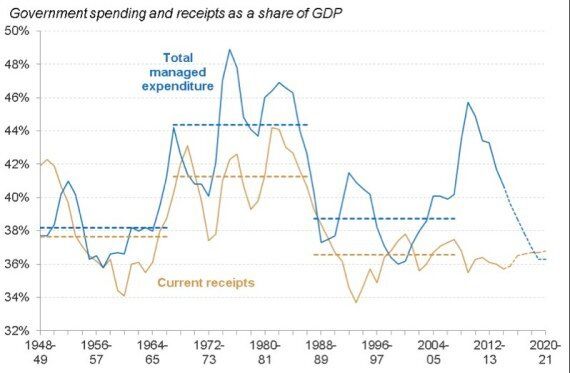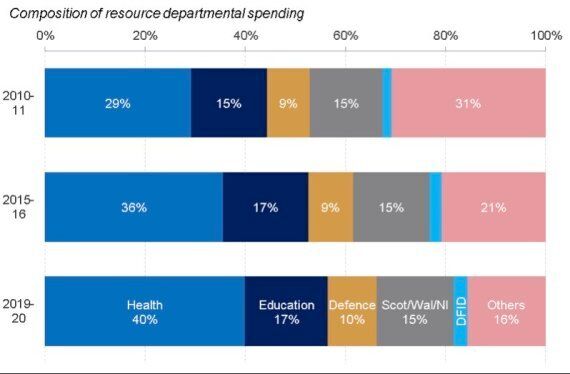What should the state do? That's the question we asked at our Shrinking Pains event on Tuesday morning. Six years into a planned ten-year period of fiscal consolidation, we took a step back - with the help of Ken Clarke, Jill Rutter and Ben Page - to consider how the process is altering not just the size of the state, but also its shape. Our presentation covered a lot of ground. Below we select seven charts that show where we are - and where we're heading.
1)Fiscal consolidation since 2009-10 has been driven primarily by spending cuts, with government spending as a share of GDP projected to approach its lowest post-war level (around 36%) by the end of the consolidation in 2019-20.

2)This reduction in total government spending as a share of GDP is equivalent to a broadly flat real-terms spending envelope. This decade-long pause in spending growth is unprecedented in modern history.

3)With overall spending broadly flat and Annually Managed Expenditure (AME) rising steadily (driven by welfare costs and debt interest payments), spending on departments (DEL) is falling sharply. By 2019-20, it is projected to have fallen by £80bn in real-terms relative to 2009-10, with around £20bn of this coming in the next four years.

4)Within the DEL budget, the Spending Review cuts are set to fall on day-to-day spending (or Resource DEL) rather than Capital DEL. With protections in place for health, schools, aid and defence, and with the Scottish, Welsh and Northern Irish budgets being set by the Barnett formula, the remaining departments face average cuts of around 29%. This would take cumulative spending cuts in the unprotected areas to more than 55% on average since 2009-10.

5)In departments such as BIS, Communities, Justice, Work & Pensions and Transport, reductions in day-to-day spending of one-third or more since 2009-10 are set to rise to a drop of between one-half and three-quarters once the consolidation is complete.

6)The nature of the distribution of cuts in day-to-day departmental spending since 2009-10 is resulting in a profound shift in the government's expenditure profile. In 2010-11, the health budget (this excludes social care, which sits in local government) was a little smaller than the combined budgets of the unprotected departments. By 2019-20, it is set to by two and a half times their size (accounting for 40% of total RDEL).

7)Add in trends in welfare bills - with growing spending per pensioner contrasting with reductions in generosity for children and working-age adults - and the role of the state looks to have fundamentally changed. The share of total government spending directed towards older people and health is rising rapidly (and is set to reach a new combined high of 43% by the end of the decade). In contrast, the share allocated to education and to economic affairs is falling rapidly (and is set to reach a new low of just 19%).

This may or may not be the right balance to strike, but there is a danger that we fail to check in on these developments until after they occur. As we head into the latest - and potentially trickiest - Spending Review of this unprecedentedly long consolidation we should be asking not just who wins and who loses over the next four years, but just what do we want the state to do?
